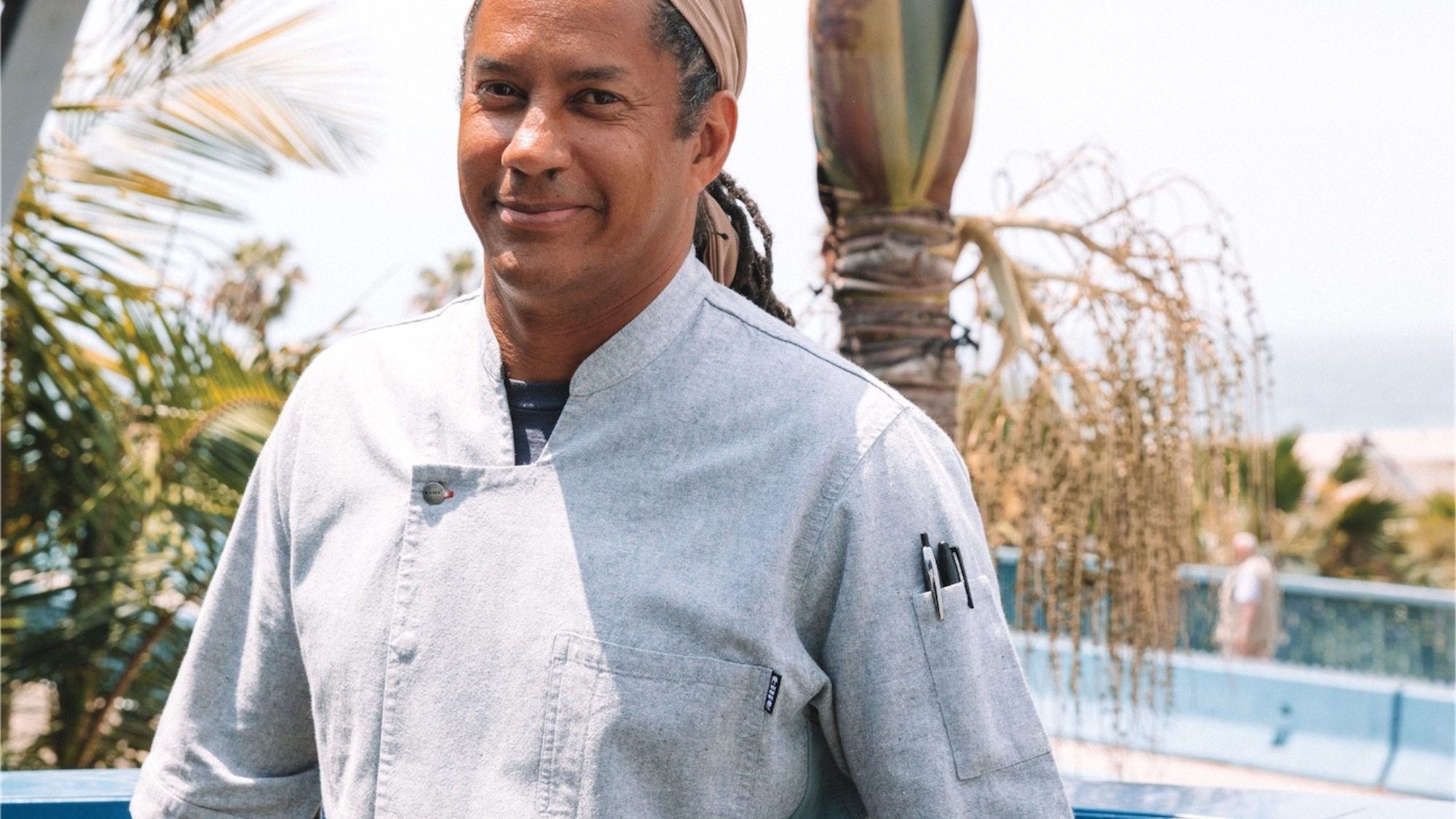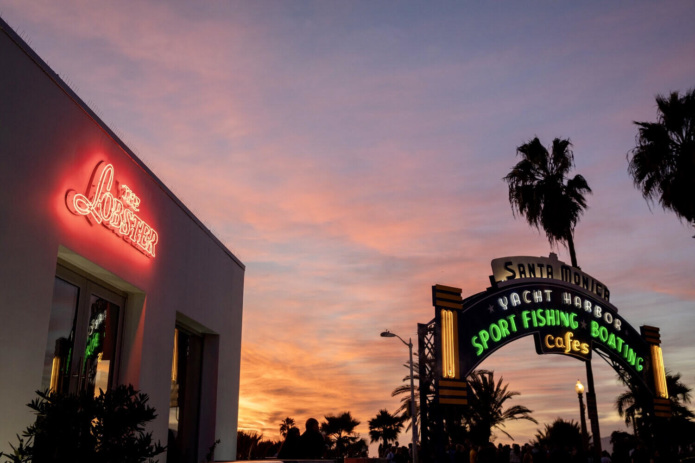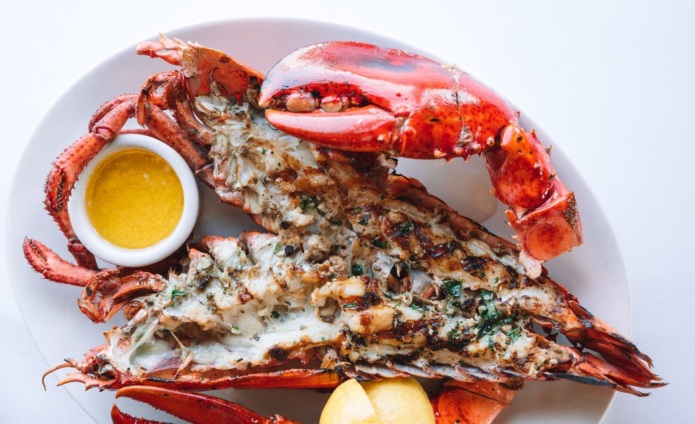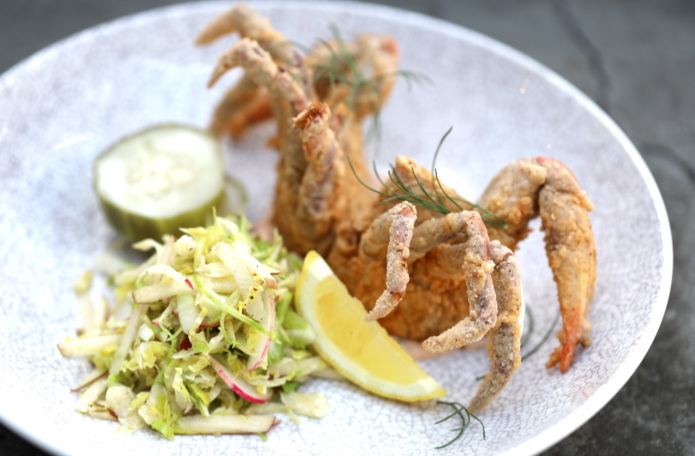
Govind Armstrong Has Seen It All, and Now He’s Paying It Forward
Imagine what you were doing after school at age 13. Chances are good it wasn’t peeling carrots at Wolfgang Puck’s Spago. But Govind Armstrong was; he kicked off his long culinary career at Puck’s original Sunset Strip restaurant in the 1980s, a time when the term celebrity chef was barely even a concept. Now, you might assert, he’s one himself.
Currently Armstrong is what he terms “culinary leader” for The Lobster, the iconic almost century-old restaurant at the top of the Santa Monica Pier. Although he took the reins as executive chef in 2017, the pandemic prompted his role to morph into more of a director of operations. So he still has his hand in all things menu-related, but thanks to more than 30 years in the restaurant industry, his talents go far beyond the pass.
Armstrong’s work is stitched into the fabric of L.A. culinary history. Born in Inglewood, and with summers spent with family in Costa Rica (his mother was born in a small fishing village on the Atlantic side), he decided early that he’d work in restaurants. After his teen stint at Spago, he worked with local chef royalty — Mary Sue Milliken and Susan Feniger of Border Grill; Nancy Silverton and Mark Peel of Campanile and so many other things; Joachim Splichal of Patina. And then created some of Los Angeles’ most memorable restaurant concepts in the early 2000s, including Chadwick with Ben Ford in 2001; a solo venture Table 8 and the burger concept 8 Oz. Burger Bar, the latter of which still has locations around the country; and Post & Beam and Willie Jane with Brad Johnson.
Some are long gone, but his impact remains, especially at Post & Beam, where he still mentors John Cleveland, the current chef and owner.
His rollercoaster of a life is as zippy as the West Coaster on the pier. The highs: sterling reviews, packed dining rooms, Top Chef, Oprah, landing on People magazine’s “50 Most Beautiful People” list. And lows: restaurant closures, underestimating business partners. Lessons learned, he’s the first to say. You pick up, reevaluate, keep moving forward.
That’s how Armstrong’s been steering the Lobster throughout the pandemic. As things begin to open up, more and more tourists are returning to Santa Monica; the dining room and bar will once again be full of locals and visiting diners looking for fresh seafood, and stunning sunsets. There’s more outdoor space, too, all with at least some view of the ocean.
Here Armstrong discusses taking over such a storied restaurant, what being a chef of color means today, and what the industry needs to do to move forward.

RESY: How did you get involved with The Lobster?
I used to bring my daughter to the beach, and we’d almost always come here. Collin Crannell was the chef, I knew him from my Pinot and Patina days. It was always a great experience, the food, the service was always on point. It was just easy and fun. I was still heavily involved with Post & Beam and 8 Oz., but owners reached out looking for a consultant, not full-time chef. I saw it as a good opportunity to take something and improve on a solid foundation. Of course, the more time I spent here, more was needed. So it sort of worked out this way. I’m actually shocked that this much time has gone by.
It’s a pretty storied place, lots of history. I imagine the staff has been there a long time, too.
Such a solid crew in place, one of the many interesting things here is the retention of staff. We have two sous chefs who have been here since [this iteration] opened in 1999. Some of the servers and bussers have all been through the last 20. It’s been enlightening to see restaurants with staying power, still retain staff, and still be able to keep people happy.
Is it much different than opening and running your own place?
Maybe a little less stress. There are definitely a ton of moving parts, and I just try to keep control of the chaos. Stepping into a restaurant that has a lot of history is its own thing. There’s a lot we want to do here, like make it more local and accessible. There’s been some tourism in Santa Monica, but it’s been down. It’s coming back now.
It was great to see our local community coming in and supporting us. They literally just jump into their favorite seats in front of their favorite window.
For instance?
Well, just yesterday we were taking down all the $20,000 worth of Plexiglass that we used for like two weeks, but then we couldn’t serve indoors. We kept some up. Slowly but surely we’ll get our restaurant back. Even at 50%, it’s nice to be able to share that view and experience again.
So the Lobster has been around for almost 100 years. This version opened in 1999. What should we know about it now? What’s changed?
In addition to updating the menu and changing how the kitchen functions, we made it a full-tip house. Everyone shares tips now. Before it was every man or woman for themselves. It worked, but there wasn’t any unity. It’s a bit of a learning curve making that switch, but once everyone understood the system and saw that everyone was making the same wage, it’s so much better.
We were careful on our end to show that it’s something worth doing. Everyone’s been flexible and understanding, which makes the transition easier. They know that their best interests aren’t being ignored. And I think guests pick up on that.

What are you most proud of on the menu right now? What kind of changes did you make?
I really just improved on what was already laid out, which was already great. I’ve worked with different vendors for a long time, so what we’re getting is better than ever before, especially our lobsters. The East Coast product, there’s no middle man, it’s all direct from the source. It’s beautiful.
Lots and lots of lobster.
We go through about 600 to 800 pounds a week, varying sizes. Honestly, it was a shocking amount even to me when I started. And we use Sea Stephanie Fish for local spiny lobsters. We’ll get whatever she catches.
Are there challenges taking on a place with so much history and built-in clientele?
Always. When you’re stepping into any new situation, I like to take it all in first, and not go and shift things overnight. I want to understand who I’m working with, the food we’re serving, etc. But I think every single restaurant has challenges. There can be a lot of bad habits people have over that course of time.
In a way, the restaurant didn’t need to be better. It’s the end of Route 66, at the top of the Santa Monica pier. All windows, views for days. There will always be customers. Why bring someone in to refine what was already offered?
That was part of what attracted me to it. They know what they’re sitting on. They own the land, they understand the potential and ease of low-lying fruit, because people already want to be here for the view. But they wanted to have a better offer. They also want to attract more locals, to maybe be a little more credible. Sometimes with a pre-existing restaurant you want a different set of eyes on it, a different game plan.
New outdoor areas were built when indoor dining shut down. Did it still attract locals?
It’s been a real mix of people coming from everywhere. The base is more local, Palisades as far as down as Mar Vista. A lot of Orange County folks and the Valley. And people from inland, Beverly Hills, Mid-Wilshire. It’s been an interesting mix. It’s refreshing to see new faces, and a lot were mostly locals. That’s what you want to see.

You worked with some of L.A.’s seminal chefs. You opened Chadwick with Ben Ford when you were young. What did you learn?
We spent way too much money to open Chadwick. We took a perfectly decent restaurant and gutted it, and that didn’t need to happen. Our vision was too grand for ourselves. Not really understanding how long it would take to pay people back. It’s not easy as an operator to be profitable. There were a lot of lessons learned. We almost made it a second year, but we opened soon after 9/11, and nothing really recovered. We decided to close before checks started bouncing. I took a couple years off and did some soul searching to figure out what I did wrong. So when I opened Table 8, I said I’m not doing this or buying that; not getting a new POS system. I spent next to nothing to open.
The original Table 8 was lovely. Truly simple design, great L.A. food. You got a lot of accolades for it. It’s interesting though. Unlike today, race was never really discussed when it came to you, or any chef for that matter.
It was never an open discussion, and it’s something that definitely had to happen. I don’t know why things take so long to be unveiled. Even as a young cook growing up, working around town, it was never discussed. The back of the house was such a different world then.
Do you feel like that’s changing?
The imbalance has always been obvious in our industry. A lot of that wasn’t at the forefront, it was never addressed in person or in food media. Maybe I got some recognition in Black Enterprise on what it’s like to be a black chef in L.A., or back in the day maybe something in Ebony. There was never a question about it in the mainstream publications. No one talked about it; maybe folks were uncomfortable bringing race up. It was always about food, why I became a chef. It took so long to say there are bigger stories to tell here, beyond the color of skin.
When you and Brad opened Post & Beam in 2011, a black-owned restaurant, helmed by a black chef, in a neighborhood that needed and deserved it, did that have heft at the time?
At that point Brad and I were already talking about doing something, we just didn’t know where. He told me the developer of that mall came to him, and he asked me what I thought. Right then, I said, let’s go and have a look. It was a no-brainer. I was from Inglewood, right next door. I had not spent a lot of time being part of the community in terms of giving something back. I always lived closer to places I worked.
So I saw it as a great opportunity to do something cool and unique for that community. There are a lot of cool little mom and pop shops around there, but we wanted to build a great restaurant, to have some names behind it, and just serve great food. We thought of different concepts, starting with pizza, but wanted to build on that. We wanted it to be full service, a seasonal menu, farmers market ingredients. I built a garden there, too, right on the lot of the Baldwin Hills Crenshaw Plaza. It was all very rewarding.
You trained current owner and chef John Cleveland. Why was it time to hand it over?
He deserves it. We needed someone great who can carry that torch. He’s it.
The mentorship never ends though, does it?
No, I was fortunate to have that at a very young age. I still cherish my relationship to Susan and Mary Sue, to Wolfgang. That’s the thing with John, too. Everyone has a mentor. I appreciate the support we’re getting from that community. Folks are still supporting it because they need it. No community should go without a restaurant that’s for them by people who look like them.
And now Martin Draluck is Cleveland’s chef de cuisine. He collaborated on those great dinners at Hatchet Hall that honored two enslaved chefs who worked in the kitchens of Thomas Jefferson and George Washington.
I’m really excited about that hire. Martin is going to help take the place to the next level. He’s very much in for the success of the business. It’s a great move. Having new blood keeps the cooks on the move, they’ll continue to grow, the community gets to have a connection to a new face.
You also helped launch careers for people like Jon Shook and Vinny Dotolo, who worked with you and Ben at Chadwick. So it’s really about creating a foundation for all young chefs to grow into their own.
It’s a matter of seeing the spark or seeing that there is not just creativity, but this person has what it takes. There’s this drive. It’s not what you teach. That was another funny time. Jon and Vinny were a two-for-one deal. There was no separating them. I was like, what? They said, “We both moved out here.” And we needed two cooks. They have great energy, they’re serious about what they do. We put them to work. It wasn’t a cake walk for anyone who stepped into that kitchen. We couldn’t be more proud of them and their success.
You’ve seen your share of restaurants come and go. Big openings, being on all the top lists, awards, and then hard closures. Situations that shed a light on bad partnerships. The pandemic must’ve been difficult. But you’ve fought to save a restaurant before.
Yeah, this is different. I’ve struggled with this one a lot. We’ve lost people who couldn’t survive with the closures, so they left L.A., or the country. It’s been beyond surreal from beyond day one. It’s going to linger for awhile. I can only take it one day at a time. All we can do is stay as positive as we can. I know we, and the industry, will survive. You just have to have a little more of a laser focus.
What do you hope to see for the industry as we all go forward?
I know it will snap back. I’ve seen a lot, from closures to recessions to complete fallout of the economy. And things do get back. We’re scrappers, restaurant people. We’ll fight our way to get the job done. And taking care of your own needs to be a priority. It’s not just about food; it’s about everyone’s well being, now more than ever. It’s going to be a tough fight. As long as people continue to support restaurants, ordering to go where they need to, and not forgetting to tip, we’ll be okay.
One more question: Do you ever get tired of Santa Monica sunsets?
Not yet. Haven’t come across a bad one yet.
- The Resy Guide to Where to Drink Right Now in Los Angeles
- Everything You Need to Know About Nossa, Now Open in Los Feliz
- The May Hit List: Guelaguetza, Hanchic, U Street Pizza, Morihiro, and More
- Madre’s Ivan Vasquez Is On a Mission to Show the Roots of Oaxacan Food
- Jon Yao’s Taiwan-Inspired Cooking at Kato, As Seen Through Five Dishes















